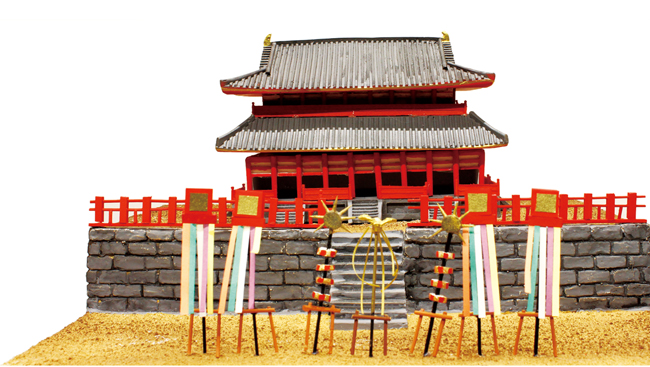
当たり前に日本人として生きてきた。でも海外に出てから、日本について何も知らないことに気が付いた。そこで、日本が世界に誇る世界遺産について建立年順に勉強しようと思う。興味がある人も、そうでない人も、しばしお付き合いを。
I’ve lived my whole life as a Japanese person, but when I went overseas I realised I know practically nothing about Japan. So now I’m learning about Japan’s World Heritage Sites, from oldest to newest. Those who are interested, and even those who are not, come along for the ride.

撮影協力 / メルボルン総領事館 Thanks to the Consulate-General of Japan, Melbourne
○○○○○ 平城宮跡 広大な敷地を誇る発掘途中の名所旧跡 ○○○○○
前回に引き続き、1998年に世界文化遺産に登録された古都奈良の文化財の中から、平城宮跡(へいじょうきゅうあと)を紹介します。この平城宮、呼び方が似ているので平城京(へいじょうきょう)と混同されることがあるのですが、平城京は「奈良時代に都があった地域」を指し、平城宮は「平城京内にある天皇の住まいや、役人達が政務を執った政庁などがあった一角」を指します。
平城京は、今から1,300年程前の710年、元明天皇が律令制に基づいた政治を行う中心地として、唐(中国)の長安をモデルに作られました。当時の平城京には、10万人以上の人が暮らしていたといわれています。そして、この平城京の北端に置かれたのが、平城宮。政治や儀式の場である大極殿・朝堂院、天皇の住居である内裏、役所の日常的業務を行う官衙(かんが)や宴会を行う庭園など、官公庁が集まった場所でした。平城宮の周りには大垣が巡らされ、朱雀門をはじめとする12の門が設置され、出入りが許されたのは、皇族や貴族、役人や使用人など、ごく限られた人達だけでした。784年に京都に遷都すると必然的に宮も京都に移り、74年間の平城京・平城宮の歴史が幕を閉じました。この74年間は、古都奈良の文化財に代表される、唐や仏教の影響を受けた壮大華麗な天平文化が花開した時代でもあります。
その後は、1852年に奉行所に勤めていた北浦 定政(きたうら さだまさ)の実測研究によって、平城宮の規模が明らかになるも、建築家で奈良の古建築を調査し、建築年代を判定していた関野 貞(せきの ただし)によって、1900年に平城宮跡の保存・保護が訴えられるまで人々の記憶から忘れ去られていました。
ところで、皆さんはこの平城宮跡が世界遺産のひとつとして登録されていることに違和感を感じませんでしたか? だって、跡ですよ。跡。以前、世界遺産についてお話した時(2014年8月号参照)に、世界遺産とは有形の不動産が対象で、その中の文化遺産は、記念物や建造物群、遺跡や文化的景観と書いた記憶が…。確かに遺跡といえば遺跡だし、そこに何かが埋まっているハズだから有形だとは思うのですが、当時の物が地上に何も残っていない状態というのは個人的に違和感が。現在、第一次大極殿、朱雀門、東院庭園が復元されいますが、どちらもこの20年内に建てられたものだし…。世界的に有名なギリシャのパルテノン神殿のように、崩れかけでもいいから地上に何か当時のものがないとピンとこないと思うのは、私だけでしょうか? そこで、調べてみました。
平城宮跡は、考古遺跡(埋蔵文化財)というカテゴリーで登録されたようです。文化庁によると、埋蔵文化財とは『土地に埋蔵されている文化財(主に遺跡といわれている場所)のことです』と、かなり直球な解説が書いてありました。勝手な想像ですが、平城宮は日本では国の特別史跡に指定され保護されています。しかし奈良市内にあり、甲子園球場が30個も入る広大な敷地は、日本の『文化財保護法』だけでは、将来の都市開発から保護できない可能性がある。そんな懸念から、更に大きな付加価値を付けるために、世界遺産に登録されたのではないでしょうか。もちろん、当時をしのぶ貴重な資料が出土し、まだまだ埋まっている可能性があるからなんですけどね。
次回は、同じく古都奈良の文化財のひとつ、東大寺を紹介します。
○○○The Heijo Palace ruins: a massive and only partly excavated historic site○○○
Continuing our exploration of the ‘Historic Monuments of Ancient Nara’, registered to the World Heritage list in 1998, this month we introduce the Heijo Palace ruins. The words for ‘Heijo Palace’ (平城宮, Heijo-kyu) and ‘the capital of ancient Nara’ (平城京, Heijo-kyo) are often confused, but actually the last kanji and the pronunciation are both slightly different.
The ancient Nara capital was established by Empress Genmei around 1,300 years ago, in 710. As the centre of the ‘ritsuryo’ government system it was modelled on Chang’an, the capital of Tang dynasty China. At the time more than 100,000 people lived in the capital. At the northern edge of the city sat Heijo Palace. It was a collection of government structures including the council hall and reception compound, where political and ritual ceremonies took place. It also included the imperial residence, offices for the everyday business of the government, and gardens for holding banquets and such. The palace was surrounded by walls with twelve gates, the main one being the ‘Suzakumon’. Only the imperial family, nobles, government officials and servants were permitted to enter. In 784, the capital and consequently the imperial residence were moved to Kyoto, ending the 74-year Nara period. It was an era that saw the flowering of the grand and splendid Tenpyo style of art, influenced by Buddhism and Tang dynasty China, and typified by the ‘Historic Monuments of Ancient Nara’.
Heijo Palace was all but forgotten. It next came to light in 1852, when Kitaura Sadamasa surveyed the area and determined the former capital’s scale, and then in 1900, when Sekino Tadashi (who had examined and determined the period of the area’s architecture) campaigned for its preservation and protection.
Incidentally, does anyone feel uneasy about the ruins of Heijo Palace being World Heritage listed? After all, they are only ruins. When I explained about World Heritage sites in the August 2014 issue, I recall writing that sites must be material places in the real world, and that cultural heritage refers to monuments, structures, ruins, and scenery of cultural importance... Certainly the Heijo palace ruins must have parts buried underground and hence are ‘material’ I suppose, but above ground there are no remaining original structures, which is a little worrying for me. The Daikokuden (Imperial Audience Hall), Suzakumon gate, and East Palace Garden have all been reconstructed within the last twenty years. Is it just me who thinks that there ought to be at least something above the ground, even if it’s crumbling like the Parthenon in Greece? I investigated further.
The ruins of Heijo Palace are also registered by Japan’s Agency of Cultural Affairs under the category of ‘buried cultural properties’. I imagine that the Heijo Palace ruins were designated to be protected as a historically important site to Japan. But being within the bounds of Nara City, and covering an area over thirty times the size of a baseball stadium, there is a possibility that Japan’s ‘Law for the Protection of Cultural Properties’ may not be enough to protect it from future urban development. Perhaps the even greater honour of World Heritage listing was sought to allay this concern. And of course, there may still be more treasures buried, waiting to tell us of the past.
Next time we introduce another of the monuments of ancient Nara, Todai-ji.

